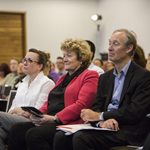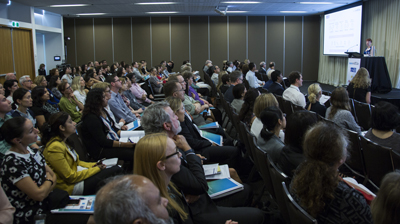
Event wrap: 26 November 2015.
The Sax institute’s 45 and Up Study is growing as a significant Big Data resource, with novel data linkages allowing researchers to embark on wide-ranging projects such as predictive modelling of disease and the using pathology records to identify chronic disease treatment gaps.
Other new directions for the Study include research into real-time data linkage, its use for data visualisation to explore preventable hospitalisations and to study patient experiences of adverse events to improve health service delivery.
“Opportunities and challenges in a Big Data environment” was the focus of the 12th annual 45 and Up Study Collaborators’ Meeting, where researchers using the Study presented some of their latest findings. Our ongoing Study into healthy ageing, now a decade old, involves one in every 10 men and women aged 45 and over in NSW – more than an quarter of a million people.
The following plenary speakers outlined novel ways which they are using data from the 45 and Up Study:
Professor Karen Canfell ‒ Big data, big potential for predictive modelling in health
Professor Canfell, Director of the Cancer Council NSW Cancer Research Division, said her organisation was using information already collected from Study participants to create computer-simulated ‘virtual populations’.
The information from these computer models could then be used to predict the risk of diseases like lung, prostate and bowel cancer, as well as predicting the health and economic impacts of prevention strategies for these diseases.
“Predictive modelling has the power to tell us what types of patients we should target to get the most benefit from health services we might offer, “ she said. “This type of work really is the next frontier in using research to help us answer important policy questions such as how can we screen for diseases like lung cancer in a way that maximises the benefits and cost effectiveness?”
She said it was also hoped the work would lead to the development of a centralised 45 and Up Cancer Research Network.
Ms Katie Irvine ‒ Yesterday’s Deaths: A new model for population-based data linkage
Ms Irvine, Manager of the Centre for Health Record Linkages (CHeReL), told the audience that up-to-date data on deaths of study participants was important for cohort management in studies such as 45 and Up. However, at the moment, there was a long time lag ‒ sometimes up to a year ‒ before data on all deaths was accessible.
She described how the Centre had designed a method to compare current linkage practices with different strategies allowing linkage of 24-hour-old data ‒”yesterday’s deaths”. High-quality and current information about deaths could be obtained through data linkage, the CHeReL work showed. However, there were trade-offs between timeliness and quality of data, with some deaths incorrectly reported and some missed in the new model.
Despite this, Ms Irvine said the research showed the enormous value of data linkage.
“We’ve achieved a lot in using linked data in NSW. We are on the cusp of a significant opportunity,” she said, adding that existing data could be linked without the need for a “big data warehouse”.
“We don’t need to have really big systems that are hackable honeypots of data in order to ensure researchers have good access to linked data,” she said.
Professor Merrilyn Walton ‒ What can patient experiences of adverse events tell us?
Professor Walton, Professor of Medical Education (Patient Safety) at University of Sydney, is drawing on a cohort from the 45 and Up Study to investigate key factors associated with adverse events in the hospital from the patients’ perspective, with the aim of redressing a knowledge gap in health in the research.
She said the study is using data linkage conducted by CHeReL to capture data on patients’ experiences in hospitals, the nature and frequency of adverse events, the impact on patient outcomes and whether patients experienced an Open Disclosure process, made a complaint or initiated legal action, over a six-month period.
Early findings suggested around 7% of the 7661 patients’ surveyed had experienced an adverse event, she said, with clinical processes and procedures the most common events
Mr Michael Falster ‒ Visualising health data to explore preventable hospitalisations
Mr Falster, an epidemiologist and biostatistician with the Centre for Big Data Research in Health at The University of New South Wales, told the meeting that data visualisation had the potential to enhance the understanding of complex patterns of information, but it was yet to be widely adopted for research into longitudinal health data.
Using the 45 and Up Study cohort, he showed how a simple data visualisation called TIPS (Trajectories of Individual Patient Service use) was used to study preventable hospitalisations, which were viewed internationally as an indicator of access to primary care.
He used linked data on hospital admissions, emergency department presentations, deaths and Medicare claims for GP and specialist consultations in 266,950 Study participants to plot patients’ use of health services before and after they were admitted to hospital. His findings, displayed visually, revealed that people with more preventable hospitalisations actually tended to have higher overall levels of engagement with the health care system – rather than limited access to primary care – in the lead up to hospitalisation.
Mr Falster urged researchers to engage with and use data visualisation tools, saying his project demonstrated how they were a powerful way of exploring and displaying patterns of health service use.
Associate Professor Meg Jardine ‒ Using community pathology data to enhance chronic disease management
Associate Professor Meg Jardine, Deputy Director, The George Institute for Global Health outlined a new projected called EXTEND45 which will see the 45 and Up Study linked to community pathology data and End Stage Kidney Disease Registry for the first time to investigate gaps in the delivery of evidence-based care for chronic disease.
She said a number of community pathology providers were supporting the project, which would focus on “silent disease” like chronic kidney disease and diabetes. For example, she said the study would be able to investigate whether people with chronic kidney disease were prescribed and adhered to evidence-based treatments like statin therapy.
“EXTEND45 augments the 45 and Up Study by the addition of longitudinal pathology variables that facilitate the identification and management of identifiable chronic disease,” she said.
The 45 and Up Study is managed by the Sax Institute in partnership with major partner Cancer Council NSW and partners: the National Heart Foundation of Australia (NSW Division); NSW Ministry of Health; NSW Government Family & Community Services – Carers, Ageing and Disability Inclusion; and the Australian Red Cross Blood Service.
Find out more
- Find out more about the 45 and Up Study
- Read other items in our news coverage of the meeting
- View the photo gallery from the day

